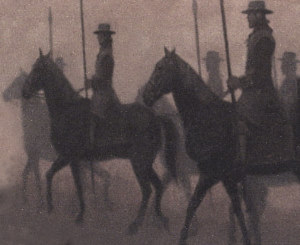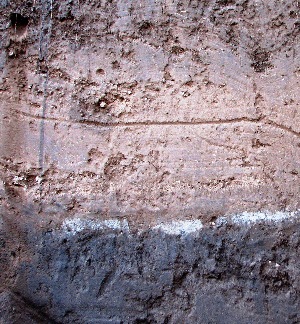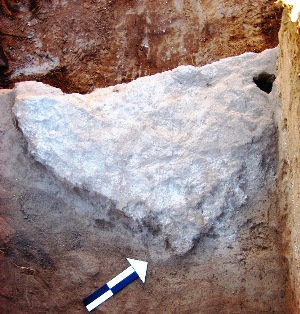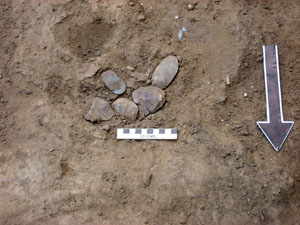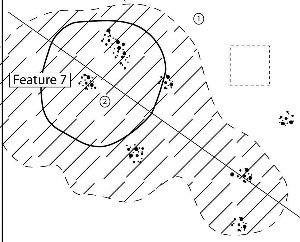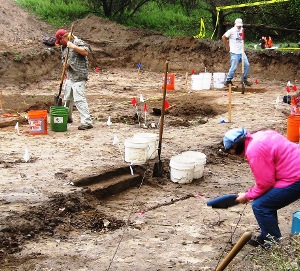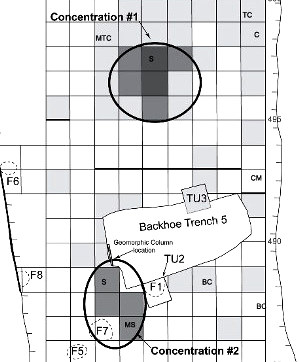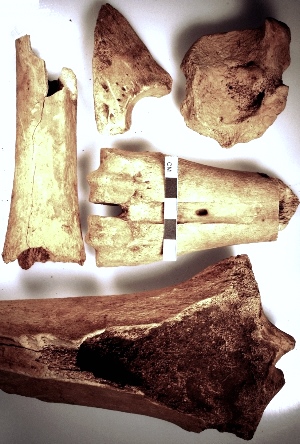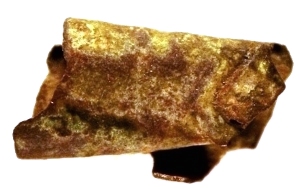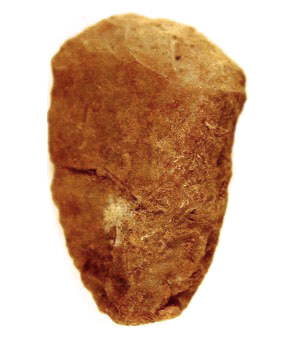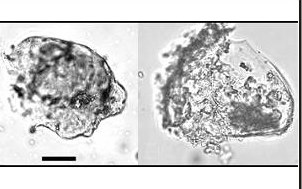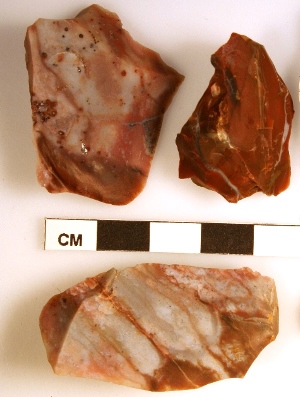Corral Site: A Rare Protohistoric Camp
Overview of Corrall site, so named for the modern wood-fenced corral alongside West Amarillo creek. Dated to roughly 200-300 years B.P., this campsite represents the Protohistoric period and is very rare in this region. |
Excavations at the Corral site (41PT186) targeted a deeply buried campsite in a low, narrow stream terrace along West Amarillo Creek. Resting about a meter below the surface, the occupational layer lay atop a well-formed buried soil (A horizon). This campsite was radiocarbon dated through two wood charcoal fragments and one bison bone sample to ca. 200 to 300 B.P., part of the Protohistoric period. During this time the region was still dominated by Native American peoples, although there was increasing interaction and trade with European explorers. Cultural materials in this section of the Corral site were in a thin, well-defined zone that represents a single camping event. Multiple flood events over the last 200 years or so brought in light colored sands and sediment which buried, sealed, and protected this campsite. Once buried, however, rodents displaced some objects upward and downward in the deposits. Fortunately, because only the one Native American occupation was identified, mixing of cultural materials had only minimal impact. Subsequent floods brought in a few animal bones and modern historic artifacts, including small chunks of glass and metal fragments that were not related to the campsite. Five cultural features (Features 1, 5, 6, 7, and 8), two concentrations of lithic (stone) materials (#1 and #2), and one cluster of bison bone were uncovered in this block. These represented areas where campers cooked, knapped stone tools, and deposited garbage, including butchered bison bone. They also buried a small cache of tools, perhaps in anticipation of a future visit to the campsite. Feature 1 was a large, white ash lens first detected in the initial backhoe trench placed into this low terrace. In the trench wall, the white ash was about 120 cm long, by about 2 to 3 cm thick and tapered to a fine line on each end. A few chunks of scattered charcoal were at each end. One charcoal chunk was radiocarbon dated through the accelerated mass spectrometer (AMS technique). This tiny sample yielded a corrected age of 230 ± 40 before present. Test Unit 2 (TU 2), a 1 by 1 m unit, then targeted this ash lens and was excavated from the surface down through this feature. No cultural materials were recovered from about the ash lens. Only a few tiny chert flakes were recovered from the margin of the ash lens. Within TU 2, the ash extended 90 cm east west by 60 cm north south and was 4 to 5 cm thick. The bottom of the ash was at 99 cm below the surface. To have created such an abundance of ash with little or no charcoal, a wood fueled fire would have had to burn long and hot enough for complete combustion of the fuel. The lack of any observed oxidation (orangish color) of the sandy loam immediately below the ash indicates the ash did not burn in place. This ash had to have been dumped here on the surface of the buried A soil horizon from some other fire event. The bottom of the ash was nearly flat with its top slightly smoothed or truncated during subsequent floods. Thus, this is a secondary discard of unwanted ash from a separate fire. Feature 5 was a small, irregular and poorly defined patch of dark-stained sediment, with charcoal flecks and chunks. A decayed root in the adjacent unit may partially account for this dark-stain. No burned rocks, ash, or other cultural materials were found. This dark matrix may have been stain from decaying natural organic matter.
Features 7 and 8 were two small basin-shaped hearths filled with white ash and mottled sediments with the occasional piece of charcoal and tiny pieces of lithic debitage. Feature 7 was an ash-filled basin/pit with ash smearing near the top. This feature was slightly disturbed during backhoe stripping, which may have removed the upper few centimeters of the northeastern section. An irregular ashy matrix extended over an area 65 to 70 cm east to west by some 40 cm north to south. Three lobes of ashy matrix extended southward beyond the central concentration. The top of what eventually turned out to be a basin, measured roughly 45 cm across, and the middle of the basin was 7 cm deep. The detected ashy matrix revealed a nearly circular basin. The basin was filled with mostly a whitish, ashy mixture underlined by a very dark grayish brown stained matrix with small (less than 1 cm in diameter) specks of yellowish red spots and tiny charcoal flecks and chunks. The ash-filled basin appeared partially outlined by a dark grayish to a very dark gray to black lens 1 to 3 cm thick. A brown sandy loam that contained flecks of charcoal was above and below the ash. The three lobes of ashy matrix at the top of the basin were very thin and difficult to discern. These lobes may have resulted from cleaning out the ash and charcoal laden matrix from the basin during the occupation. Feature 7 was about 2 m southwest of ash dump Feature 1. Nearly 19 liters of sediment collected from Feature 7 were floated in a water tank in the laboratory. The resulting heavier items recovered included three tiny pieces of lithic debitage, 73 tiny pieces of charcoal, two tiny unburned bone fragments, two burned seeds, and one unburned hackberry seed. The material that floated to the surface included many tiny rootlets, and insect parts along with some tiny charcoal flecks. The charcoal included more than 25 pieces of mesquite and 16 flecks of indeterminate plant species. Feature 7 is interpreted as an in situ basin-shaped heating element that was allowed to burn completely out. This created the mostly ashy fill with a thin charcoal-laden matrix lining the basin. If the thin lobes of ashy matrix to the southwestern side of the basin reflect cleanouts, then this basin appears to have been cleaned out more than once during the occupation. Tiny lithic debitage pieces were found in the very top part of Feature 7. These flakes may have originated from an identified flint knapping area immediately adjacent the actual basin on the eastern side. The presence of the flakes may indicate that an individual was flint knapping, while sitting next to this heating element. The ash dump Feature 1 also yielded tiny microdebitage in the ashy matrix. It is likely that the ash in Feature 1 was cleaned out of this heating element.
|
|
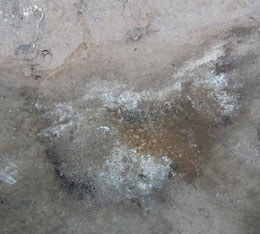
|
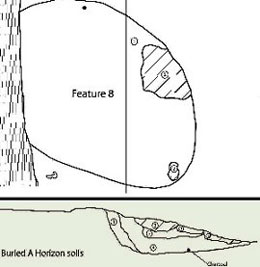
|
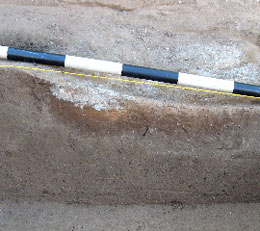
|
